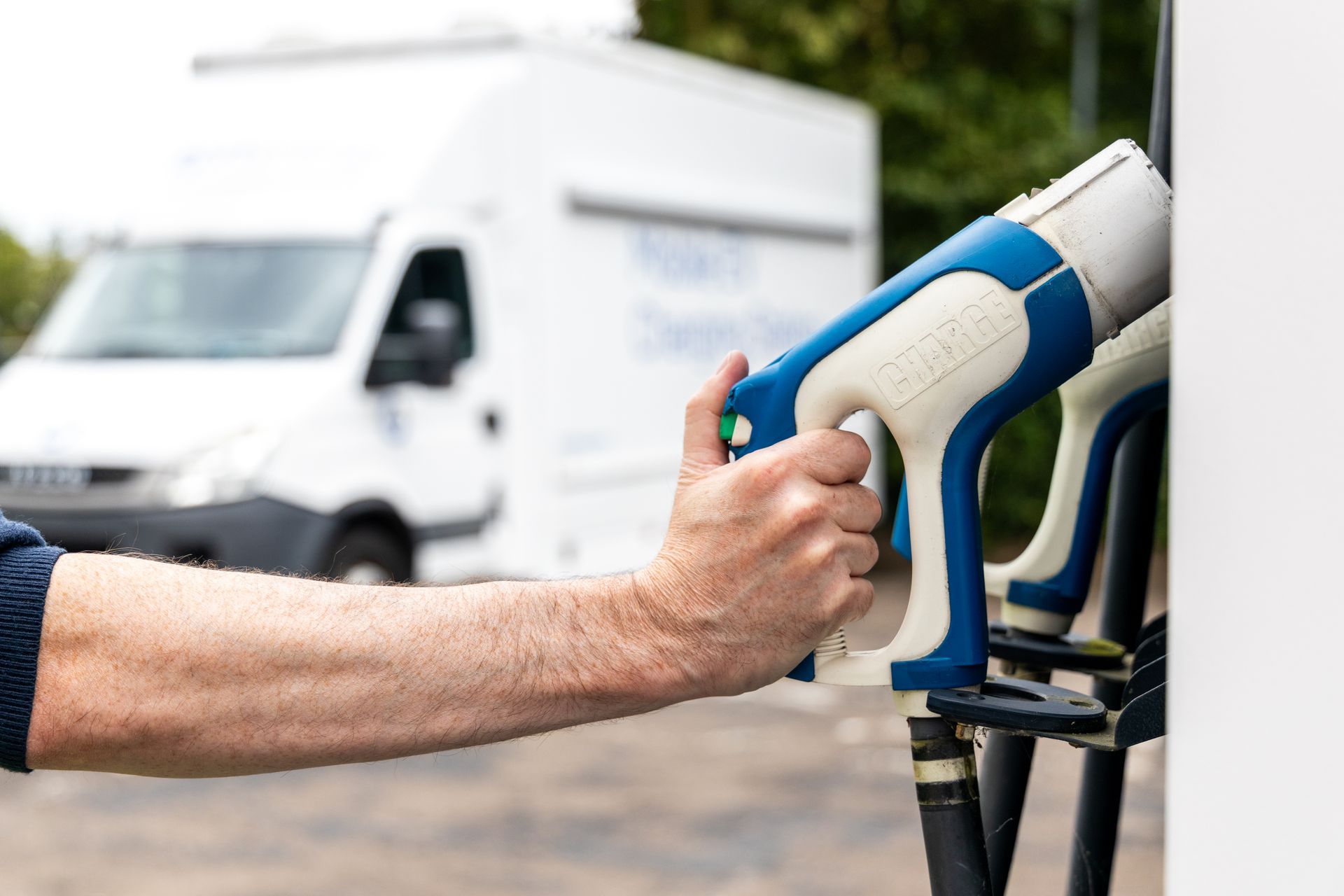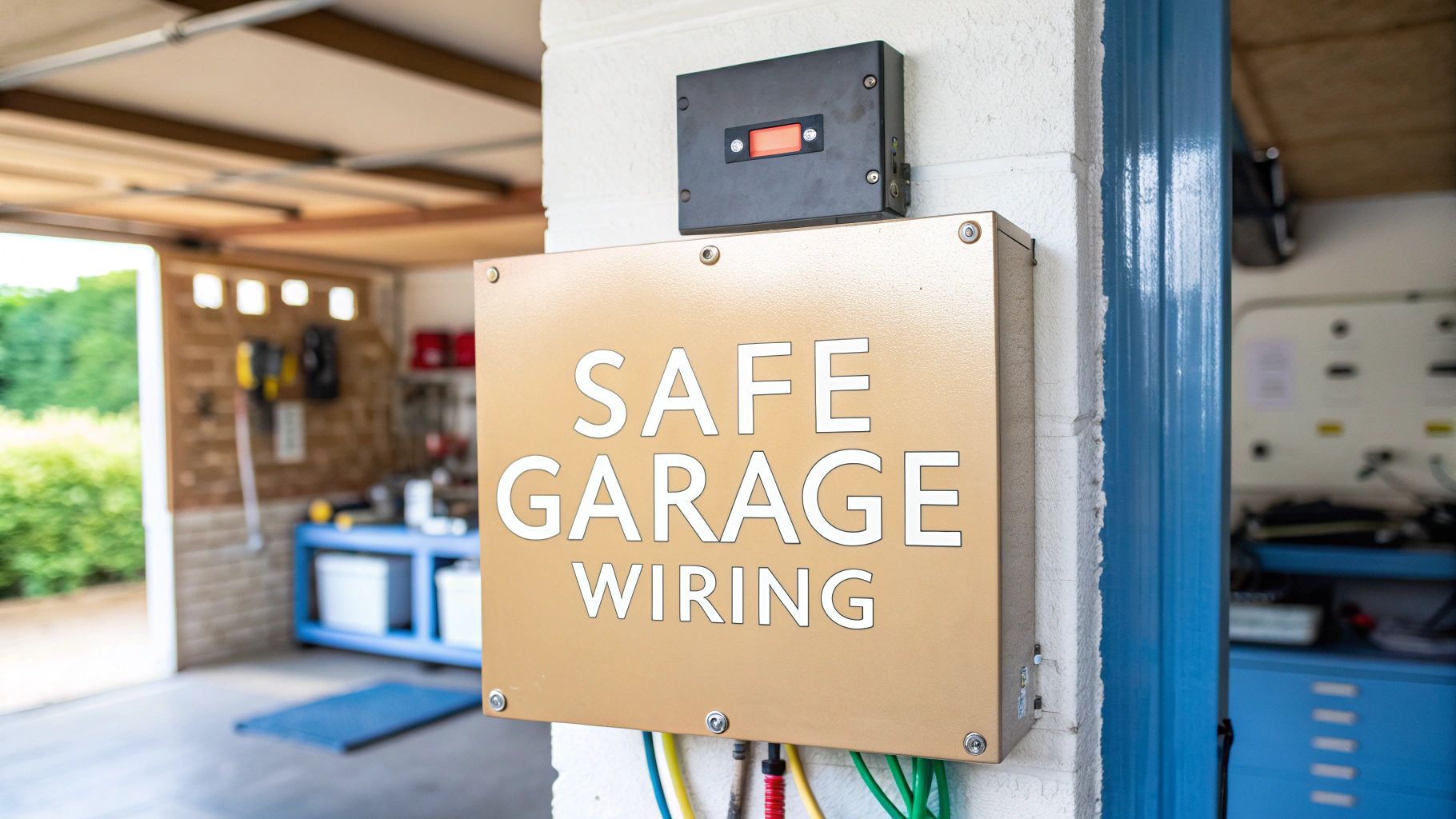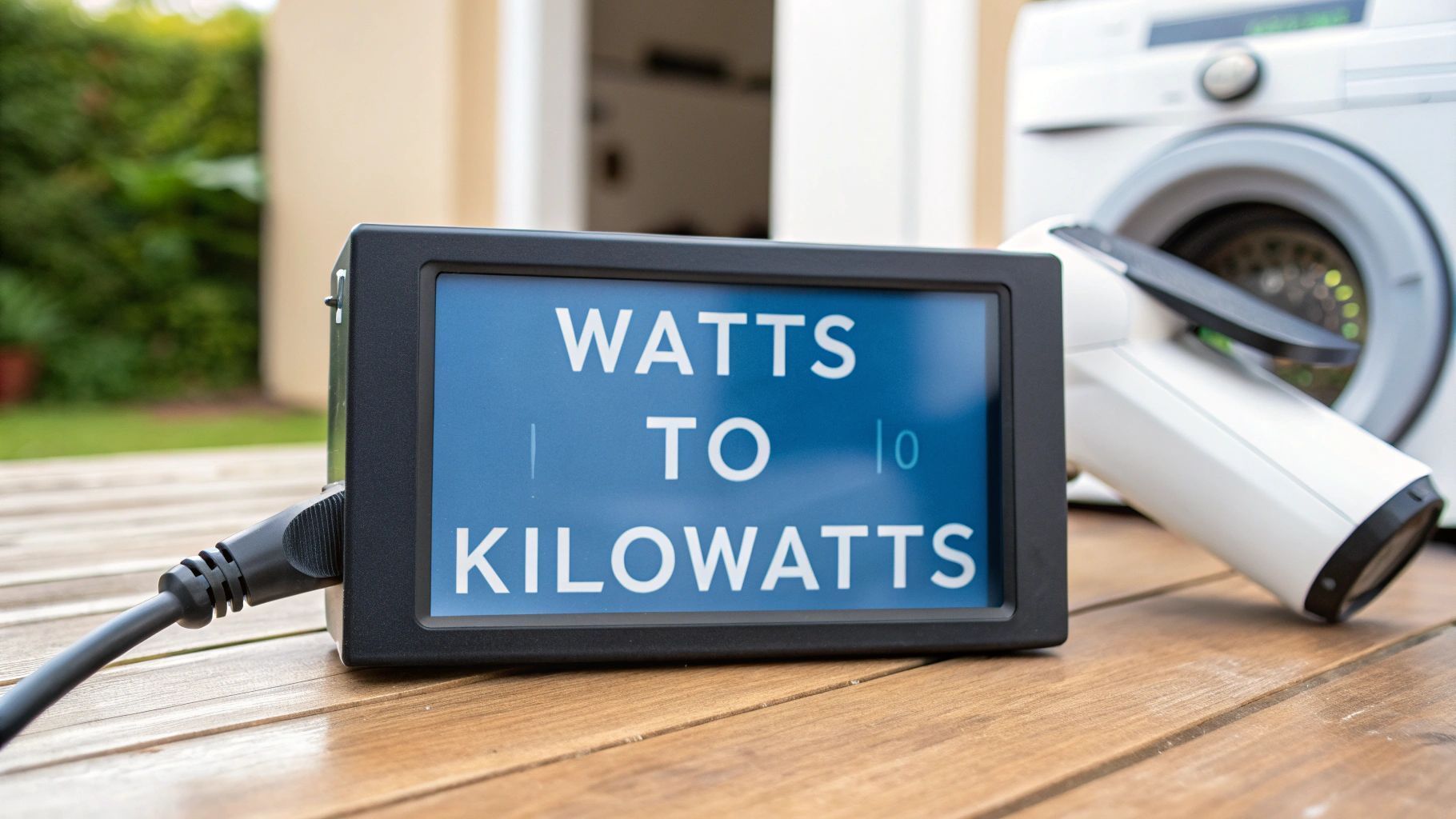EV Charging Workplace Your Guide to On-Site Profit
Offering EV charging at your workplace has moved firmly from a "nice-to-have" perk to a crucial business decision. It is a direct response to your employees' needs, a powerful boost to your company's image and a clear signal that you're a forward-thinking leader in a crowded market. It’s a strategic move that can genuinely improve how you attract and keep the best people.
Why Your Workplace Needs EV Charging Now
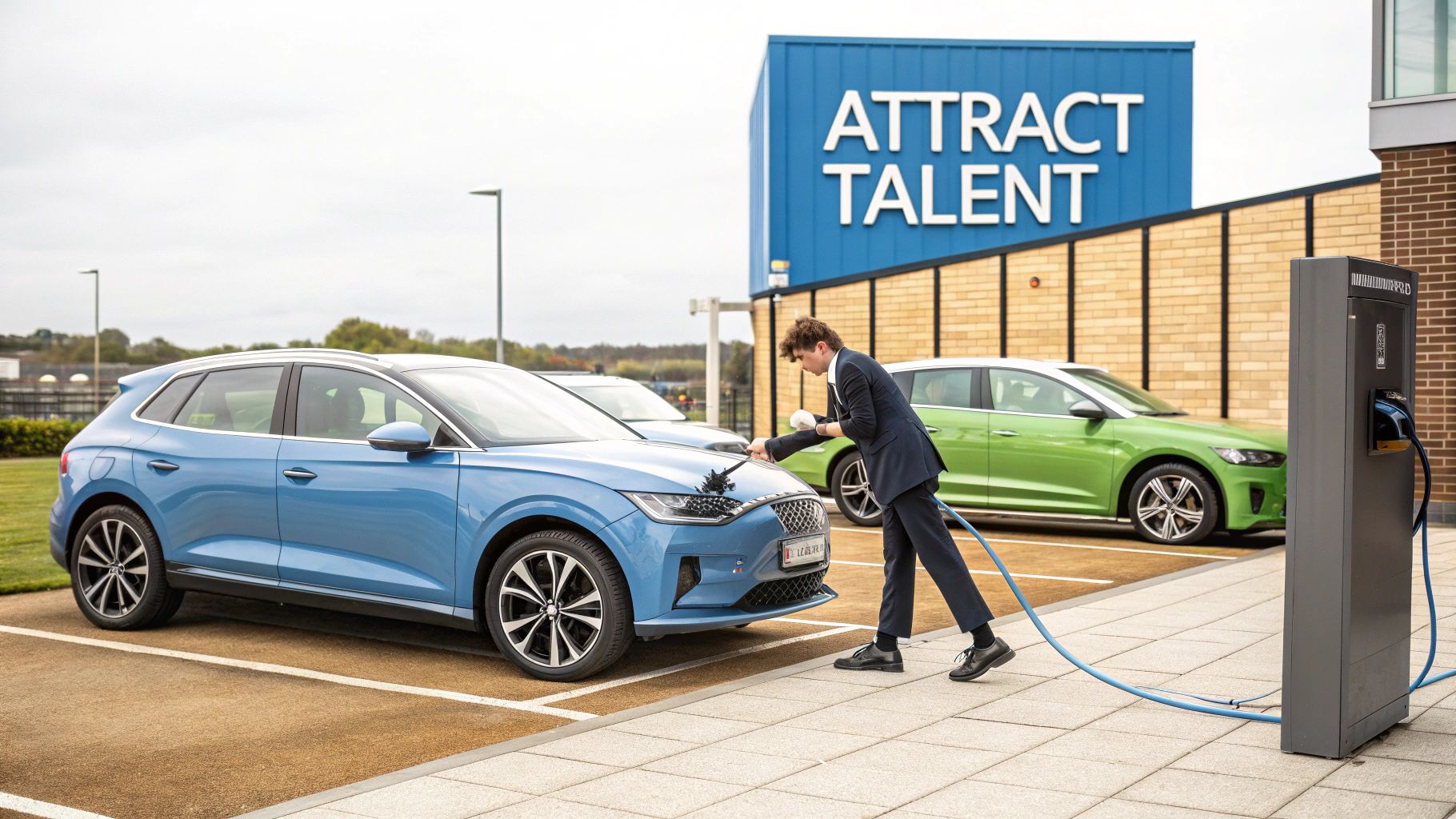
The whole conversation around workplace EV charging has changed. It is no longer just an amenity; it’s a competitive necessity. As the UK continues its rapid shift to electric vehicles, your team will increasingly expect you to support their sustainable transport choices. Dragging your feet on this can put your business at a real disadvantage.
Providing chargers on-site solves some of the most common headaches for EV drivers. It wipes out range anxiety on the daily commute and provides a lifeline for staff living in flats or homes without their own driveways. It’s a simple, practical way to show you’re listening to your team and are invested in their well-being.
Attract and Retain Top Talent
In today's job market, especially when you're trying to attract younger professionals, a company's real-world commitment to sustainability is a massive draw. Offering EV charging sends an immediate, powerful message that your organisation is modern, environmentally conscious and genuinely supportive of its people. It's a tangible benefit that can easily tip the scales when a top candidate is weighing up offers.
The data backs this up. With most employees parked at the office for hours every day, it's the perfect place to top up. In fact, a staggering 88% of employees say that parking availability—including EV charging—directly impacts their overall job satisfaction. For them, it can be a cost-effective solution, potentially saving hundreds of pounds a year compared to relying solely on home or public charging.
"For businesses, workplace charging is a visible and impactful way to demonstrate corporate social responsibility. It supports sustainability goals, reduces the collective carbon footprint and aligns the brand with the future of transport."
A Strategic Business Advantage
Looking beyond the immediate employee benefits, installing charging points is simply a sound business strategy. You’re future-proofing your property and demonstrating that you can adapt to changing infrastructure demands. As businesses evolve, so too must their facilities, and EV charging is a key trend shaping the future of facilities management.
This proactive approach sharpens your brand’s reputation with customers, partners and the wider community. It shows your company isn’t just keeping up with change but is actively leading the way. The benefits of rolling out an ev charging workplace programme are clear and immediate, making it an essential move for any UK business that wants to thrive.
Choosing Your Charging Solution: Fixed vs. Mobile
So, you're ready to bring EV charging to your workplace. Fantastic. One of the first big decisions you'll face is whether to go for traditional, fixed chargers or opt for the flexibility of a mobile solution. It's a crucial fork in the road.
Fixed chargers—those wall-mounted boxes you see everywhere—often feel like the default option. But I've seen many businesses dive in, only to find themselves tangled in a web of unexpected problems.
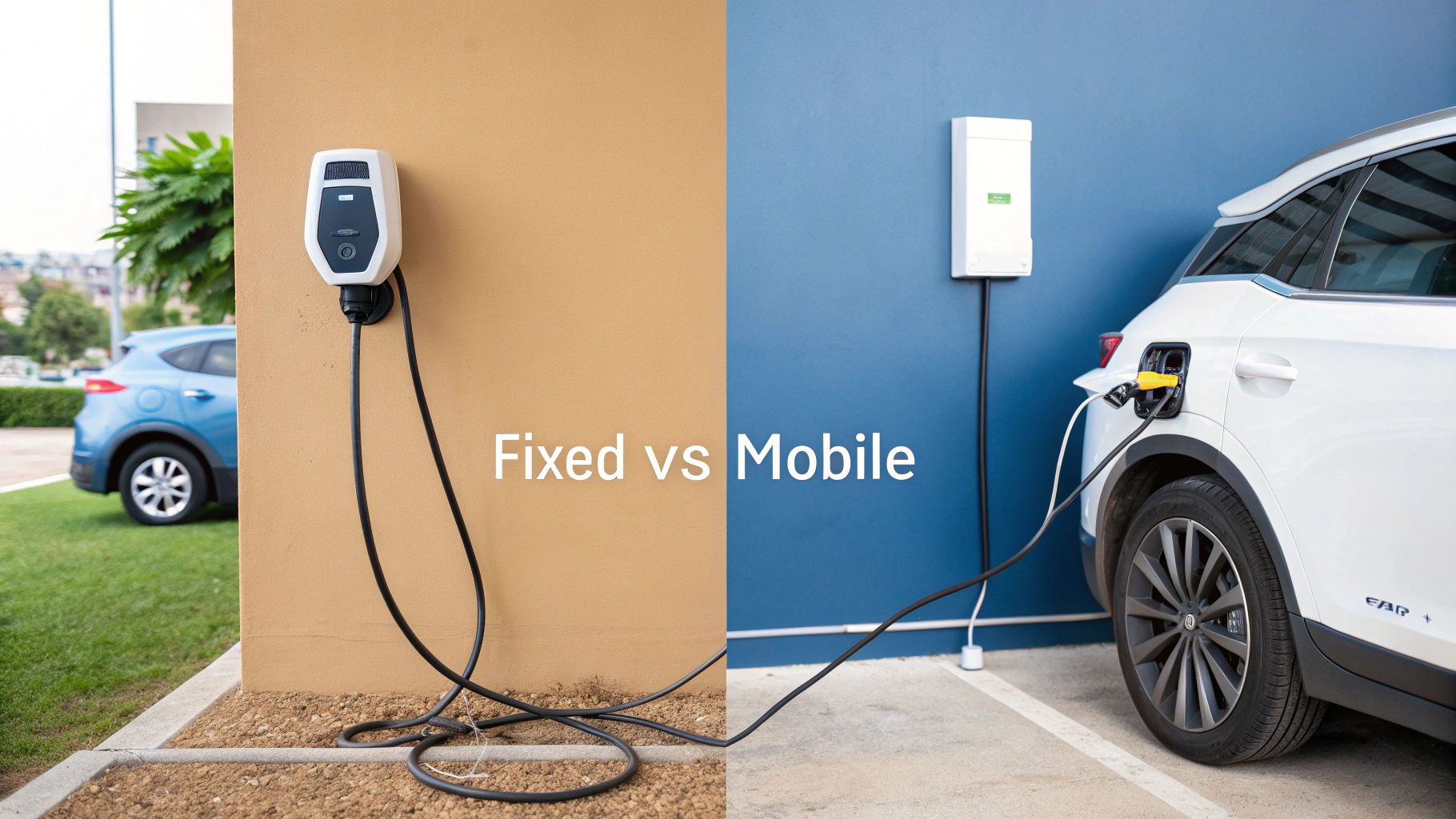
Let's be honest, the installation process for fixed units can be a nightmare. We're talking about serious civil engineering works, like digging trenches across your car park to lay armoured cables. It's messy, expensive and often triggers the need for planning permission, which can stall your project for months.
And if you’re leasing your property? Forget it. Most landlords won't let you start digging up a car park you don't own. This is where mobile charging solutions really come into their own, offering a much smarter, more practical path forward.
The Agility of Mobile EV Charging
Think of mobile chargers, like our ZAPME units, as powerful battery packs on wheels. They can be rolled out instantly, wherever and whenever you need them, without a single shovel breaking ground. This completely sidesteps the infrastructure headache and offers a unique opportunity for entrepreneurs to generate significant income.
An operator of a mobile charger can establish a highly profitable business with minimal upfront cost. Imagine a typical office park where the grid supply is already stretched. Installing fixed chargers would mean a hugely expensive electrical upgrade but with mobile units, you can start with just one or two, charge them from a standard wall socket and move them between vehicles to generate revenue all day. It's the perfect way to test the waters, see what the demand is and scale up your operation intelligently.
The real beauty of mobile charging is its adaptability. It lets a business introduce an EV charging service immediately, learn from real-world usage and grow the programme without the financial risk or physical disruption of a fixed installation. For an operator, it's a turnkey business model.
A Smarter Financial and Practical Choice
Financially, the case for mobile chargers is incredibly strong. By sidestepping those eye-watering installation costs, you massively lower the barrier to entry for offering an EV charging workplace solution. The capital you save can be put to better use elsewhere in the business or used to expand your mobile fleet as demand inevitably grows. If you want to dive deeper, you can learn more about the future of EV charging by comparing stationary vs mobile solutions.
To help you weigh your options, let’s break down the key differences.
Mobile vs. Fixed EV Chargers: A Practical Comparison
| Feature | Mobile Chargers (e.g., ZAPME) | Fixed Wall-Mounted Chargers |
|---|---|---|
| Installation | None required. Plug and play. | Extensive. Requires trenching, cabling and potential grid upgrades. |
| Cost | Low upfront cost, no installation fees. | High upfront cost for hardware plus significant installation expenses. |
| Flexibility | Extremely high. Move units to any parking space as needed. | Zero. Chargers are permanently fixed to one location. |
| Scalability | Easy. Add more units incrementally as demand grows. | Difficult and expensive. Requires more installation work for each new unit. |
| Leased Properties | Ideal. No permanent alterations to the property. | Often not feasible due to landlord restrictions. |
| Disruption | Minimal. Can be deployed and used immediately. | High. Causes major disruption to car parks and business operations. |
As you can see, the mobile approach offers a far more agile and cost-effective way to get started.
The UK's charging landscape supports this. Slower 3-7 kW chargers are perfect for workplaces where cars are parked all day and they now account for over 55% of all public devices . Mobile units deliver this ideal slow charge perfectly but without being tethered to the wall.
Ultimately, for many UK businesses, a mobile-first strategy offers far greater flexibility and just makes better financial sense. It lets you start small, prove the concept and grow your charging service in a way that truly aligns with your employees' needs and your building's limitations.
Turning Your Mobile EV Charger into a Revenue Stream
It’s easy to think of workplace EV charging as just another staff amenity—a necessary cost in the modern world. But that perspective misses a huge opportunity. A mobile EV charger is far more than an expense; it's a flexible asset that can generate a substantial new income stream for a savvy operator.
By treating a mobile EV charging workplace solution as a profit centre, you’ll find it pays for itself surprisingly quickly. It’s a smart, profitable business move waiting to happen.
Unlike fixed installations that demand hefty capital investment and disruptive groundwork, a mobile charger lets an operator enter the market with minimal financial fuss. This opens the door to a simple but powerful business model: you provide a high-demand service and you get paid directly for it. Let's break down exactly how that works.
Building Your Charging Revenue Model
The most direct way to earn is by setting a price for the electricity you supply. You're in complete control here, so you can establish a pricing structure that easily covers your own electricity costs while generating a healthy profit margin on every single charge.
But simply selling energy is just the start. The best revenue models layer multiple income streams to maximise your earnings and, just as importantly, keep the charger available for the next paying customer.
Here are the key components you can put in place:
- Charging Session Fees: This is your bread and butter. You set a competitive but profitable price per kilowatt-hour (kWh). For instance, if your electricity costs £0.20 per kWh, you could charge drivers something like £0.45 per kWh.
- Idle Fees: These are essential for keeping the charger in play. An idle fee is a small charge that kicks in when a car is fully charged but still plugged in, blocking others from using it. It’s a gentle nudge that encourages drivers to move their vehicles, freeing up the unit for someone else.
- Subscription Models: Got regular users, like staff in a shared office park? Offer them a monthly subscription. This could give them a certain number of charging sessions or a discounted rate for a recurring fee, creating a predictable and steady revenue base for you.
A Real-World Earnings Scenario
To see how this plays out, picture an operator with a single mobile charger at a multi-tenant business park. The park is full of employees who drive EVs but there's no charging infrastructure on site—a perfect gap in the market.
The operator keeps it simple, setting a price of £0.50 per kWh delivered to the car.
On a typical workday, the operator serves four different vehicles. Each driver just needs an average top-up of 20 kWh to get them home and ready for the next day. The maths is pretty straightforward:
- Revenue per car: 20 kWh x £0.50/kWh = £10.00
- Total daily revenue: 4 cars x £10.00 = £40.00
Just like that, a single mobile charger is bringing in £40 a day. If the operator works a standard 20 days a month, the revenue really starts to add up.
Monthly Revenue Potential: £40 per day x 20 days = £800 per month
That £800 is from just one charger, operating only during normal business hours. With potential earnings like this, an operator running a small fleet of mobile chargers could generate a very significant income. For a complete financial breakdown, you should explore the economics of mobile EV charging in our deep-dive model.
This simple scenario shows just how accessible and profitable mobile EV charging can be. It’s a business model that requires minimal setup but offers substantial returns, turning any car park into a source of consistent, scalable revenue.
Launching Your Workplace Charging Programme
Alright, you’ve done the research and you're ready to get your workplace charging programme off the ground. Getting from plan to action is all about taking a clear, logical approach. It starts with figuring out initial demand and moves right through to setting fair rules and prices. A successful launch is always built on thoughtful prep work, so let's walk through the practical steps to roll out a service that works for the business and your team.
First things first, you need a handle on how much demand there actually is. The easiest way to do this? A quick survey for your staff. Just ask a few straightforward questions about their current EV situation or if they're planning on getting one soon. This gives you a baseline to work from.
That little bit of information is gold. It helps you decide how many mobile chargers you might need from day one and really shapes your entire strategy. It’s a low-effort way to gather solid data before you commit to anything.
Creating a Fair Usage Policy
Once you have a sense of demand, it’s time to draft a clear and fair usage policy. This document is your best friend for preventing confusion and making sure everyone has a good experience. Keep it simple, easy to understand and make sure it’s shared with all staff before the chargers go live.
Your policy should cover the essentials:
- Booking Process: Explain exactly how employees can reserve a charging slot. Is it an app? A shared calendar? Let them know.
- Charging Etiquette: Set clear expectations. The big one is moving a vehicle once it’s fully charged so the next person can get in.
- Pricing Structure: Be completely transparent about any costs. That means spelling out the price per kWh and any idle fees for overstaying.
- Reporting Issues: Give people a clear point of contact if a charger isn’t working or they run into any other problems.
A well-defined policy is the foundation of a smooth-running ev charging workplace programme. It manages everyone’s expectations and helps you sidestep any potential squabbles over charger access.
Logistics and Pricing Strategy
With your policy in place, let's think about the day-to-day practicalities. Where will the mobile chargers be stored securely overnight? Who’s going to be responsible for wheeling them out in the morning and keeping an eye on the schedule? Assigning these responsibilities from the start prevents operational headaches down the line.
Finally, you need to decide on your initial pricing. You've got a few ways you could play this and each one serves a different goal. You could offer charging as a free perk to boost morale, provide it as a subsidised amenity or run it as a proper profit centre. The right choice really just depends on your business objectives.
This infographic breaks down how simple it is to turn your charging service into a revenue stream.
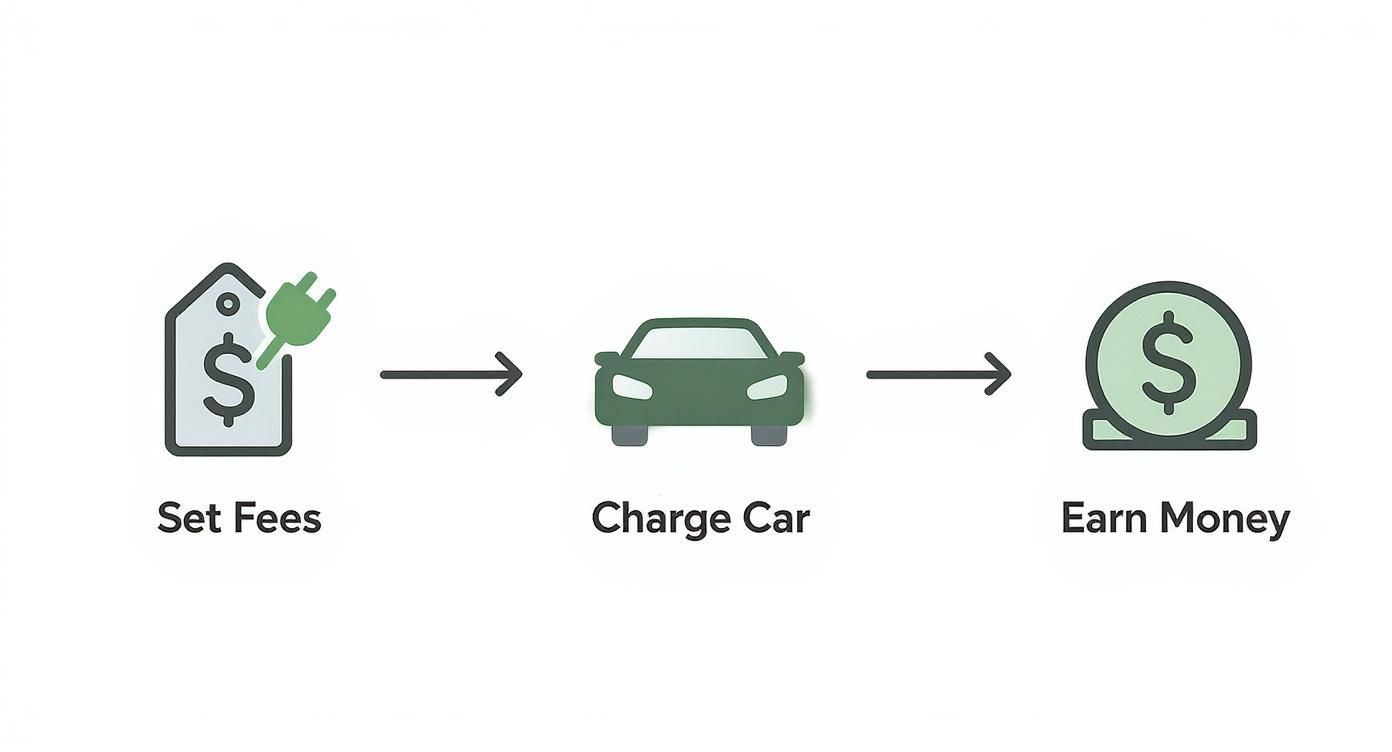
As you can see, the model is pretty straightforward. You set your fees, provide the service and generate income. It’s a great way to turn a workplace amenity into a valuable asset.
The UK EV Charging Landscape Today
To get workplace charging right, you first need to understand the bigger picture. Seeing where your own plans fit into the wider UK market shows exactly why now is the time to act, so you don’t get left behind.
The national push towards electric mobility isn’t just a passing trend; it’s a fundamental shift, backed by serious government action and major investment.
This rapid transition means installing an EV charging workplace solution is far more than a nice-to-have employee perk. It’s a direct alignment with national priorities. By adding this infrastructure, you’re actively contributing to the UK’s ambitious goal of phasing out new petrol and diesel cars by 2030. It’s a proactive stance that boosts your brand image and gives you powerful stories for your Corporate Social Responsibility reports.
Riding the Wave of National Growth
The growth across the country has been nothing short of remarkable. The UK's public charging network expanded by a massive 25% between January and September 2023 alone, reaching over 46,000 public charging points .
This incredible momentum shows just how fast EV adoption is happening but the country still needs thousands more chargers to keep up with future demand. For a deeper look at the current infrastructure, you can explore our guide to understanding the UK’s public EV charging point networks in 2025.
Workplaces are a critical piece of this puzzle. The government has committed a staggering £1.6 billion to expand the charging network, all to support an estimated 14 million EVs by 2030. This huge investment makes one thing clear: public infrastructure can't do it alone. They’re counting on businesses to step up.
Your business can be part of the solution. By offering on-site charging, you’re helping to build the robust national infrastructure needed for a fully electric future, positioning your company as a forward-thinking community leader.
Tapping into Government Support
The UK government isn’t just asking for help; it's actively encouraging businesses to get involved with financial incentives. The Workplace Charging Scheme (WCS) is a fantastic voucher-based programme designed to help cover the upfront costs of buying and installing EV charge points.
This grant can significantly reduce your initial investment, making the decision to install chargers much easier to justify on the balance sheet.
The scheme reveals a clear government strategy. They recognise that convenient access to charging at work is one of the most powerful ways to persuade more people to switch to an EV. By taking advantage of these grants, you’re not just making a smart financial move—you’re becoming an active player in a major national mission to build a cleaner, more sustainable transport system.
Of course. Here is the rewritten section, crafted to sound like it was written by an experienced human expert, following all your specified requirements.
Common Questions About Workplace EV Charging
When you start looking into an EV charging programme for your workplace, a lot of questions are bound to come up. It's only natural. Getting the right solution for your business means getting clear, straightforward answers first. Let's tackle some of the most frequent queries we hear, especially around the practical side of flexible, mobile solutions.
How Much Can I Realistically Earn?
This is usually the first question on everyone's mind and the answer is genuinely encouraging. Your earnings are a direct result of your pricing model and how often the charger is used. An operator of a mobile charger sets a price per kWh but can also add a small connection fee or even idle fees to make sure the unit is always free for the next paying customer.
Let's run through a simple, realistic scenario. Say you charge a competitive £0.45 per kWh . If you serve just four employees who each need a 20 kWh top-up during the day, that's £36 in daily revenue. Over a typical month, that single mobile charger could bring in over £700 in income . Imagine the potential with a small fleet of chargers across several locations.
And remember, that calculation doesn't even factor in extra revenue from other fees. It just shows how quickly a mobile charger can go from being an amenity to a profitable asset for an operator.
The key takeaway here is that mobile charging isn't just another business expense; it's a revenue-generating service. With a smart strategy, a mobile unit can pay for itself and start turning a profit much faster than you’d expect from a fixed installation.
Do I Need Planning Permission for Mobile Chargers?
This is where mobile solutions really shine. In most cases, the answer is no. Because mobile chargers don't require any groundwork, trenching or permanent fixing to the ground, you can typically bypass the long and often expensive process of seeking planning permission from your local council.
This means you can get your charging service up and running almost immediately, without the usual bureaucratic headaches.
What if Our Building’s Power Supply Is Limited?
A very common and valid concern. It's precisely this kind of situation where a mobile solution is the perfect fit. A fixed installation could force you into a costly grid upgrade if your building's electrical capacity is already stretched.
With mobile chargers, however, you can start small. Bring in one or two units to test the waters and carefully monitor the impact on your existing electrical system. It's a low-risk approach that lets you scale your fleet up or down based on your building's capacity and what your employees actually need, all without a huge upfront investment.
How Are Bookings and Payments Managed?
Modern mobile charging solutions like ZAPME are handled entirely through a simple, intuitive app on your phone. There’s no admin for your facilities team to worry about.
Employees just use the app to:
- Find an available charger nearby.
- Book a time slot that works for them.
- Pay securely for their charging session.
The whole process is automated, taking the administrative burden off your plate and giving your staff a seamless, professional experience from start to finish.
Ready to turn your car park into a profit centre with a flexible, hassle-free EV charging solution? Explore the possibilities with ZAPME and see how our mobile chargers can work for your business at https://www.zapme.biz.

